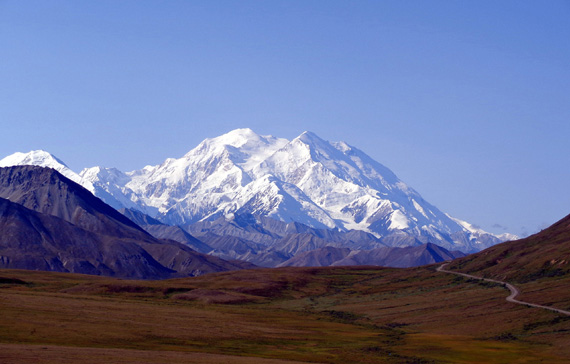This summer we're playing much of our itinerary "by ear," with very few
campground reservations. That gives us more flexibility to maximize good
weather conditions and opportunities to be outside hiking, cycling, and sight-seeing --
and to move somewhere else if it's going to rain for a while!
After Jim decided not to ride the Kluane to Chilkat International bike
race we left Haines a week earlier than originally planned. That gave us
more time to visit Valdez, a town we enjoyed when we were here three
years ago.
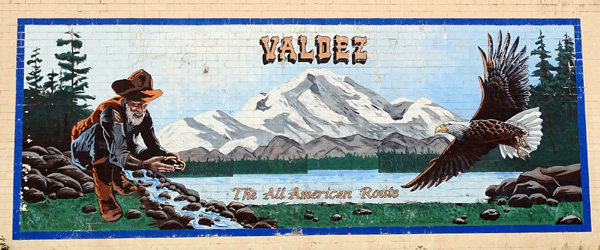
This mural on a brick wall in town illustrates
Valdez's role in the Klondike Gold Rush.
The weather determined how long we're here. Since it has been warmer
and more sunny than the last time we were here, we're staying five days
before moving on.
This entry focuses on the campground and nearby
Valdez Glacier Lake and Robe Lake.
VALDEZ GLACIER CAMPGROUND
This large, heavily forested campground is run by the Army (Fort Greeley) but is open
to the public. The military rate is $5 less per night than the civilian
rate.
The campground is on
located about three miles out Airport Road, which intersects with the
Richardson Hwy. three miles north of town = six miles to town from the
campground.
Here's a map I used
in 2012 that shows the proximity of the campground (arrow pointing left)
to the glacier, Robe Lake, town, Mineral Creek, Solomon Gulch Fish
Hatchery, Solomon Lake, and other places I'll be talking about in this
series of entries about the Valdez area:
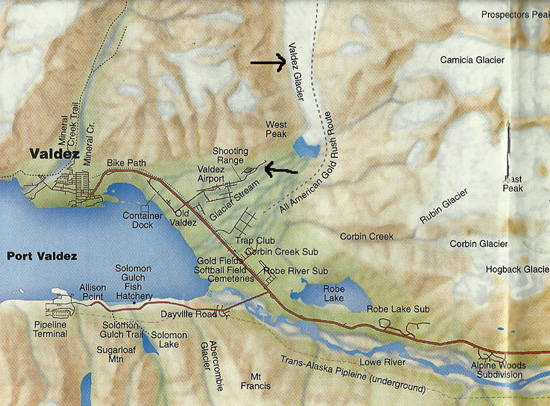
When we were here three years ago for three nights the twenty sites with
electricity were only half full. All of them are back-ins along the side
road closest to the entrance. We can fit into the majority of them but
not most of the remaining 80+ pull-thru and back-in sites that are more
wooded and off more narrow roadways. Those sites are small, very rustic,
and have no hookups at all.
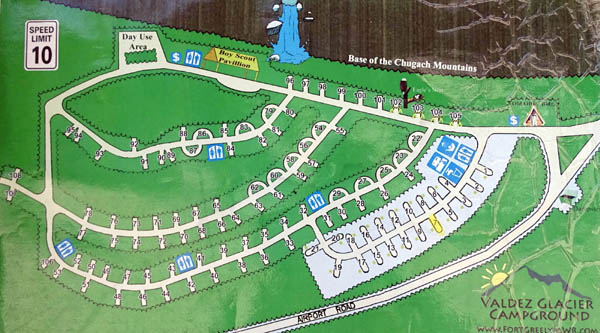
I marked our site (on the right) in yellow.
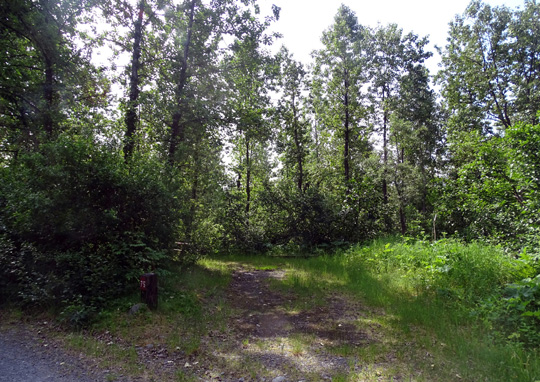
One of the no-hookup sites, which probably hasn't
been occupied yet this summer
The twenty sites with 30- or 50-amp electricity do not have water or
sewer. Six of them have rental trailers on them that are often occupied
on weekends. That leaves just fourteen sites with electricity left for
visitors with their own RVs. Potable water and a dump station are
located near the entrance.
Since no one can make reservations to camp here, we arrived on
a weekday when more electric sites were likely to be available. We were hoping to
get the large, secluded site we had three years ago.
When we arrived
on Wednesday afternoon we discovered that the site we
previously occupied now has a tiny mobile "cabin"
on it for visitors to rent, so that was out.
Only two of the sites with electricity were available that were large
enough for the Cameo and truck. The one we chose had plenty of room to back
in the rig and we can park
the truck either next to or in front of it:
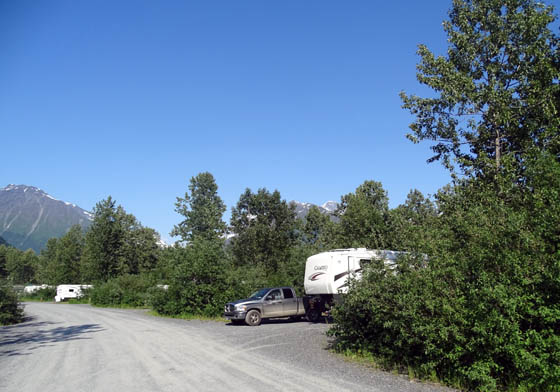
We like this relatively large site. It has thick shrubs and trees on either side
and the back for privacy, it is oriented well to the sun and mountain
views, and it's fairly close to the campground entrance.
We wanted just 30 amps at the $25/night military rate ($30 for the
general public). This is a 30 + 50-amp
site. The campground host said if we hook up to the 30 amps we could pay
$25/night instead of $30/night military rate for 50 amps. If we needed to hook up to 50
amps for some reason, we had that option for an additional $5 (we didn't
need it).
The Verizon phone signal is weak at our site but we're
able to make most phone calls and get on the internet OK with our personal MiFi.
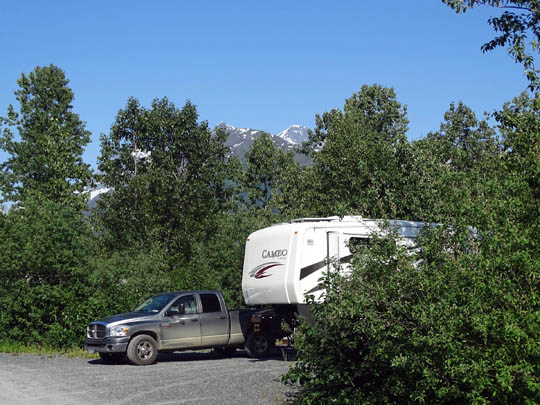
The camper and truck were dirty from the drive from Haines -- a
common problem for visitors driving through Alaska or northwest Canada.
Jim filled the water tank on the way into the campground and he was able to rig up the
hose to wash the camper with minimal water from our tank.
He washed the truck in town. It got dirty again pretty fast, even on
paved roads. It's lush
green everywhere but, like the rest of Alaska, this area hasn't received
as much rain as usual. The gravel roads are very dusty, including the
ones in the campground, and work trucks hauling rocks and sand to town
for a major construction project keep the roads pretty dirty.
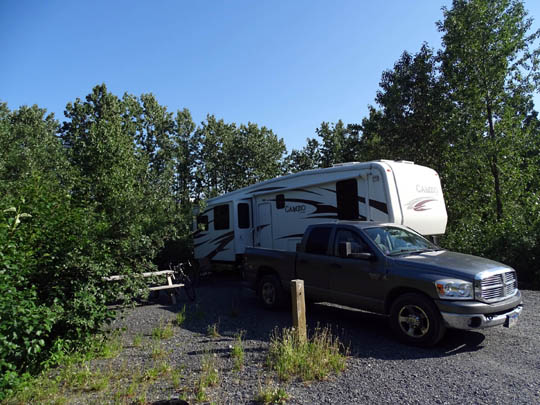
By the weekend all the RV sites with electricity were full but there
were only about a dozen no-hookup camper and tent sites occupied.
We noticed that the young couple in a Class A motorhome a couple sites
beyond us had a lively chocolate Lab, Ellie, so we intercepted them one day when they
were walking the dog. Cody and Casey made a good photo op
of all three Lab colors
as Rachel tried to get all of them to sit at once. They finally did,
but not in this shot:
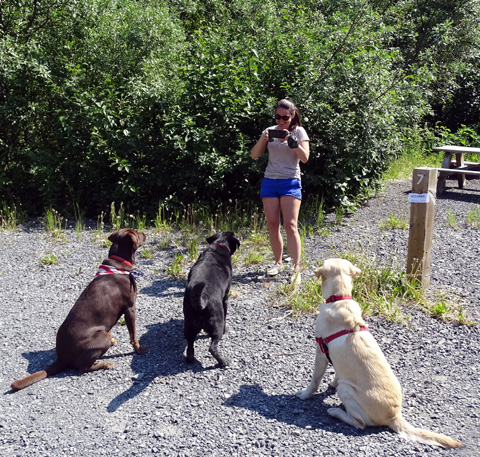
Rachel and Spencer have been full-time RVers for three years, which is
unusual for a couple so young (I'd guess late 20s). They have a
business they conduct online. They often boondock to save on travel
costs but an internet connection is critical for their business. They're
spending the summer in Alaska and have already explored much of North
America.
Sometimes I wish I'd done something like that at an earlier age but Jim
and I didn't even know about the lifestyle until after we'd retired.
Better late than never!
ROBE LAKE
Soon after getting set up in our campsite we started exploring the area
and getting reacquainted with the town of Valdez. Two of the first
places we visited were nearby lakes, in hopes of finding some new trails
to hike.
This was our first time to go up to Robe Lake, which is a few miles
north of town and just off the Richardson Hwy.:
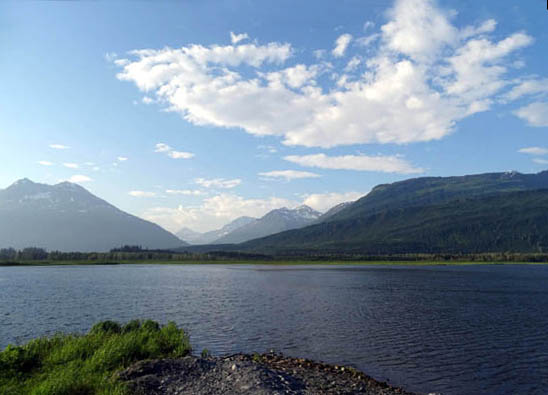
This scenic lake is popular for fishing but I didn't see any trailheads.
It would be fun to hike all around the lake.
VALDEZ GLACIER LAKE
I haven't found any trails around the lake at the end of Airport Road,
either, just a big jumble of boulders.
Our campground is about three miles back Airport Road. The road
dead-ends in another couple miles at the lake formed by melting glaciers in the Chugach
Mountains to the west and north of Valdez, including large Valdez Glacier.
This glacier played a key role in the establishment of the town in the
late 1890s.
Valdez became a port of entry for gold seekers headed to the
Klondike gold fields near Dawson City. The original All American Route took thousands
of optimistic stampeders up and over Valdez Glacier, a very dangerous route with deep,
unseen crevasses and other perils. The trail was
later rerouted through Thompson Pass. The pass gets more snow than
just about anywhere else on earth but at least it's not a glacier.
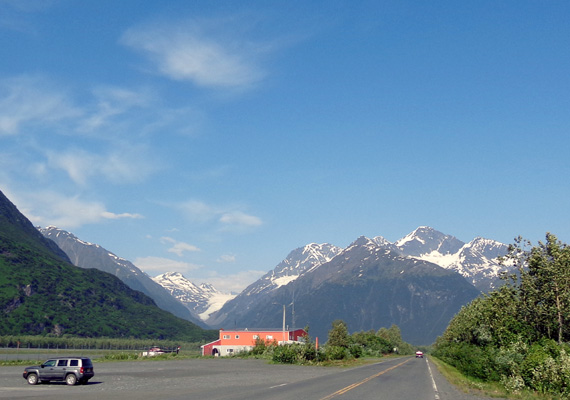
Glaciated area at the end of Airport Rd.; our
campground is between the airport and the glacial lake.
Today Valdez Glacier has retreated far enough that you can't see it
unless you either scramble half a mile through large boulders or fly over it.
However, you can see other beautiful glaciers from Airport Road and from
the pretty lake at the foot of the mountains at the end of the road:
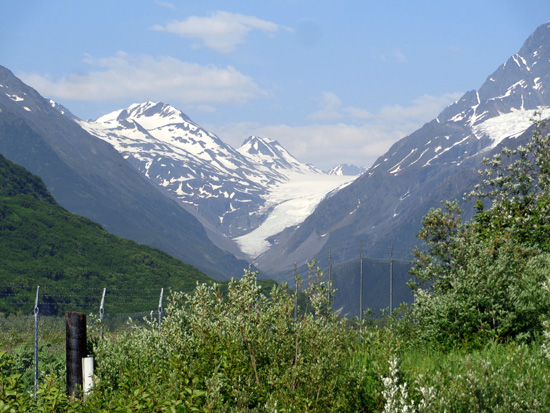
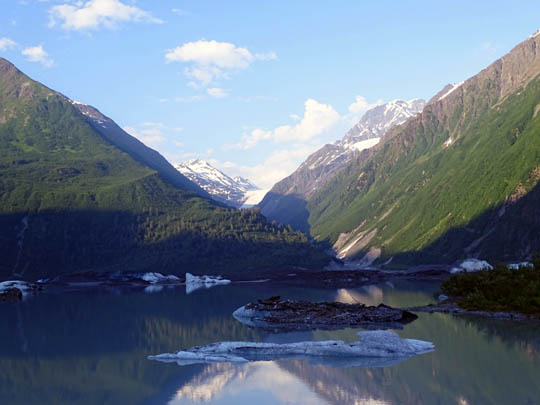
Our campground is about two miles from this lake. On the first day we heard some
very loud blasts emanating from this area. The campground host
advised us that many tons of rock are being blasted from a mountainside
near the lake to use in Valdez harbor, which is being expanded to accommodate
more boats.
We can see where the
mountainside is being blasted:
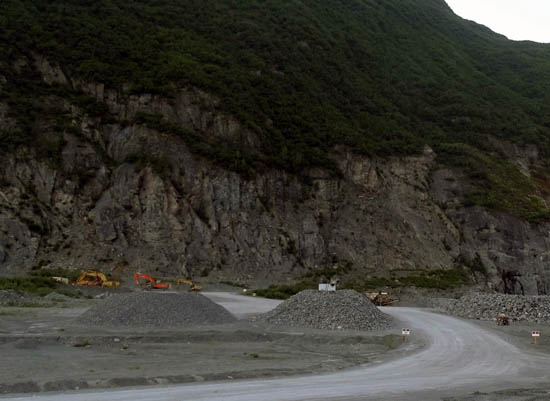
Fortunately for us, the large trucks hauling it out use another road
along the river to reach the main highway into town, not Airport Rd.
These photos from the harbor area show how crowded the current small
boat harbor is; many boats are parked on land because there isn't
enough room in the water:
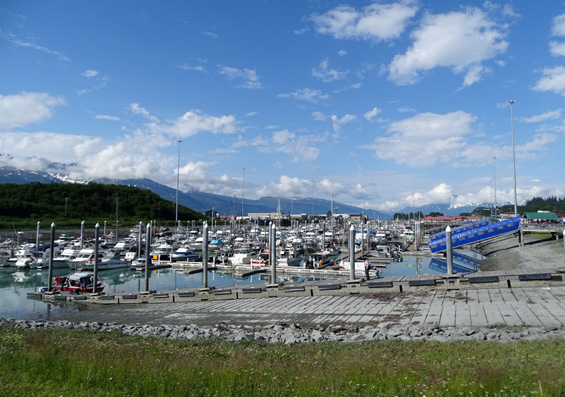
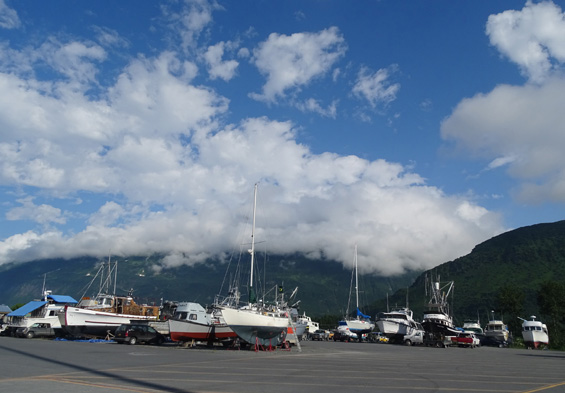
This sign shows the proposed new harbor area, which won't be finished
for another three years:
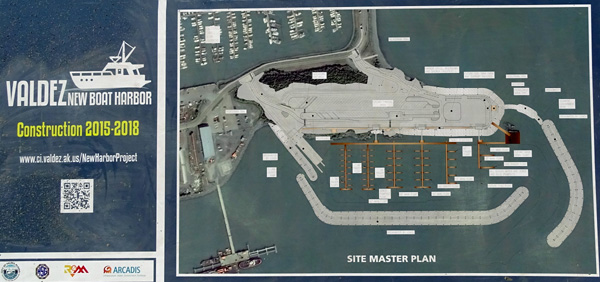
These pictures show some of the early progress in moving tons of rock
and soil to form the new harbor area:
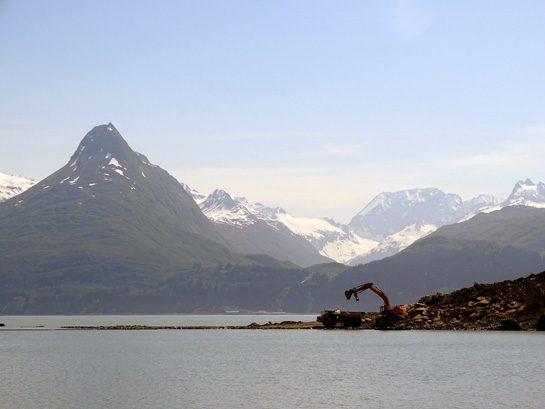

All this work currently makes the northern half of Valdez a mess.
Big trucks are constantly hauling rocks to the site and going back up the
Richardson Hwy. for more. Even though they don't use Airport Rd.,
we have to deal with the noise, dust, and mud on the main highway and in
town every time we go in. We're glad we aren't in a couple of the campgrounds
right next to their route.
On the other hand, the visitors in those RV parks don't have to listen
to the blasting like we do at Valdez Glacier CG. Each blast of dynamite
also vibrates our camper a little bit.
In addition, the small planes going into and out
of the nearby airport, plus a shooting range on the other side of our
campground, make this a noisy place to camp.
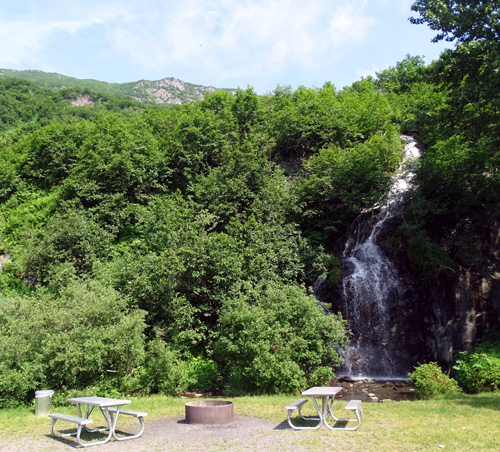
Above and below: A pretty waterfall in our
campground offers some respite from the noise.
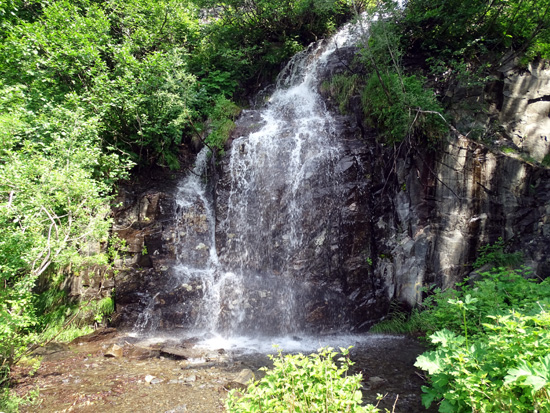
On the positive side, we're usually gone during the day and it's quiet
at night.
Compared to the other RV parks in and out of Valdez this is the most
reasonably priced for us (military rate) and has the most spacious
sites. I bet the other campgrounds in town don't have their own bald
eagle nests, either! The eagles are fun to watch.
We initially paid for three nights but ended up staying for five
because the weather was good and we found plenty of things to do. I'll
talk about our activities in subsequent entries.
Next entry: more scenes in town, including the harbor, Solomon
Gulch Fish Hatchery and the Whitney Museum
Happy trails,
Sue
"Runtrails & Company" - Sue Norwood, Jim O'Neil,
Cody the ultra Lab, and Casey-pup
Previous
Next
© 2015 Sue Norwood and Jim O'Neil
